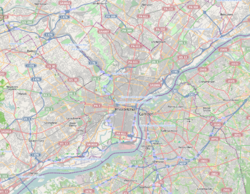Wagner Free Institute of Science
|
Wagner Free Institute of Science
|
|
 |
|
| Location | 1700 West Montgomery Avenue Philadelphia, Pennsylvania |
|---|---|
| Coordinates | 39°58′50″N 75°9′47″W / 39.98056°N 75.16306°WCoordinates: 39°58′50″N 75°9′47″W / 39.98056°N 75.16306°W |
| Built | 1859-1865 |
| Architect | John McArthur, Jr.; Collins & Autenrieth |
| Architectural style | Classical Revival, Renaissance |
| Website | www.wagnerfreeinstitute.org |
| NRHP Reference # | 89000361 |
| Added to NRHP | May 17, 1989 |
The Wagner Free Institute of Science is a natural history museum in Philadelphia. It was founded in 1855 by William Wagner, a merchant, philanthropist, and gentleman scientist of the time, who sought to offer free educational courses to all who would seek to learn about the natural world. Wagner began offering free lectures on science at his home, Elm Grove, a colonial farm estate on the outskirts of Philadelphia in 1847. To illustrate the lectures he drew on a collection of specimens he had gathered since his boyhood. All of the classes were offered with an open admission policy that allowed women as well as men to attend. These lectures became so popular that by 1855 he moved them first to a public hall to accommodate the rapidly growing audience, and later to its permanent home designed by Philadelphia architect John McArthur, Jr., who would go on to design Philadelphia's City Hall.
Wagner continued to lecture and to lead the unique institution until his death in 1885. The Board of Trustees then appointed Joseph Leidy, a biologist of international reputation, to head its scientific and educational programs. Leidy's appointment ushered in an active and productive era in which the Institute's mission and programs were greatly expanded. Leidy's most lasting and significant contribution to the Institute was his reorganization of the Institute's museum. He greatly enlarged Wagner's original collection by further field collection, purchases and other acquisitions. Leidy personally developed and supervised their reorganization into a systematic display in which specimens and cases were arranged according to Darwin's theory of evolution, so that visitors moved from simpler to more complex organisms and through geologic time as they walked through the exhibition hall. This new display opened in 1891 and little has been altered since Leidy's time, making the Institute an exceptional example of a Victorian era science museum.
The Institute has continued to carry out Wagner's initial goals of offering free science courses, while also functioning as a library, lecture hall and museum. Today, the Wagner Free Institute of Science is widely recognized as one of Philadelphia's historical treasures. While preserving its historic building and collections for future generations to enjoy, the Institute also serves as a rich educational resource for programs on science, natural history, and the history of science from the 19th century to the present.
...
Wikipedia



